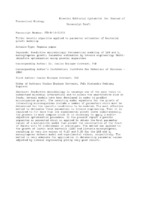| dc.creator | Pedrozo, Héctor Alejandro | |
| dc.creator | Schvezov, Carlos Enrique | |
| dc.date.accessioned | 2023-01-30T13:02:44Z | |
| dc.date.available | 2023-01-30T13:02:44Z | |
| dc.date.issued | 2016-11-14 | |
| dc.identifier.citation | Pedrozo, H. A., y Schvezov, C. E. (2016). Genetic algorithm applied to parameter estimation of bacterial growth modeling. Journal of Theoretical Biology. [s/d]: Elsevier, pp. 1-25. | es_AR |
| dc.identifier.other | CCPI-CNyE-A-131 | |
| dc.identifier.other | 9305 | |
| dc.identifier.other | JTB-D-16-01015 (Manuscript Number) | |
| dc.identifier.uri | https://hdl.handle.net/20.500.12219/4442 | |
| dc.description | Fil: Pedrozo, Héctor Alejandro. Universidad Nacional de Misiones. Facultad de Ciencias Exactas, Químicas y Naturales. Instituto de Materiales de Misiones; Argentina. | es_AR |
| dc.description | Fil: Pedrozo, Héctor Alejandro. Consejo Nacional de Investigaciones Científicas y Técnicas. Centro Científico Tecnológico (Nordeste). Instituto de Materiales de Misiones; Argentina. | es_AR |
| dc.description | Fil: Schvezov, Carlos Enrique. Universidad Nacional de Misiones. Facultad de Ciencias Exactas, Químicas y Naturales. Instituto de Materiales de Misiones; Argentina. | es_AR |
| dc.description | Fil: Schvezov, Carlos Enrique. Consejo Nacional de Investigaciones Científicas y Técnicas. Centro Científico Tecnológico (Nordeste). Instituto de Materiales de Misiones; Argentina. | es_AR |
| dc.description.abstract | Predictive microbiology is nowadays one of the main tools to understand microbial interactions and to assess the quantitative risk in foods. Several models have been developed in order to predict microorganism growth. The resulting model equations for the growth of interacting microorganisms include a number of parameters which must be determined for the specific conditions to be modeled. The most effective method to determine these parameters is inverse engineering. When it is required to fit more than one experimental growth curve simultaneously, the process is more complex since it is necessary to apply a multi- objective optimization procedure. In the present report a genetic algorithm is presented which is applied to obtain the best parameter values of a mechanistic model that permit the construction of the front of Pareto with 50 individuals or phenotypes. The method was applied to the growth of lactic acid bacteria (LAB) and Listeria monocytogenes, resulting in very low errors of 0.23 and 0.25 for the LAB and L. monocytogenes between model and experimental values, respectively. The method is very adequate for application in determining parameter values adjusted by inverse engineering giving very good results. | en |
| dc.format | application/pdf | |
| dc.format.extent | 1.120 MB | |
| dc.language.iso | eng | en |
| dc.publisher | Elsevier | en |
| dc.rights | info:eu-repo/semantics/openAccess | |
| dc.rights.uri | http://creativecommons.org/licenses/by-nc-sa/4.0/ | |
| dc.subject | Predictive microbiology | en |
| dc.subject | Bacterial interactions | en |
| dc.subject | Parameter estimation | en |
| dc.subject | Genetic algorithm | en |
| dc.title | Genetic algorithm applied to parameter estimation of bacterial growth modeling | en |
| dc.type | info:eu-repo/semantics/article | |
| dc.type | info:ar-repo/semantics/artículo | |
| dc.type | info:eu-repo/semantics/draft | |




